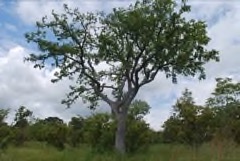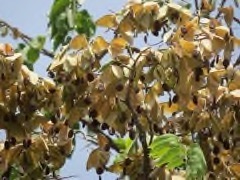 |
|
westafricanplants.senckenberg.de |
 |
| westafricanplants.senckenberg.de |
Translate this page:
Summary
Physical Characteristics

 Daniellia oliveri is a deciduous Tree growing to 25 m (82ft) by 25 m (82ft) at a fast rate.
Daniellia oliveri is a deciduous Tree growing to 25 m (82ft) by 25 m (82ft) at a fast rate.
See above for USDA hardiness. It is hardy to UK zone 10.
Suitable for: light (sandy), medium (loamy) and heavy (clay) soils. Suitable pH: mildly acid, neutral and basic (mildly alkaline) soils. It cannot grow in the shade. It prefers moist soil.
UK Hardiness Map
US Hardiness Map
Synonyms
Paradaniellia oliveri Rolfe
Plant Habitats
Edible Uses
Edible Parts: Leaves
Edible Uses:
Tender young leaves - cooked and eaten as a vegetable[617 ]. The young leaves are only eaten in times of scarcity[317 ]. The leaves are being used increasingly as a replacement for Vitex doniana leaves, which have become more difficult to obtain due to over-exploitation[617 ].
References More on Edible Uses
Medicinal Uses
Plants For A Future can not take any responsibility for any adverse effects from the use of plants. Always seek advice from a professional before using a plant medicinally.
A decoction of the root is used in the treatment of gonorrhoea and skin diseases[46 ]. The gum-resin, obtained from the wood, is used medicinally[317 ]. The leaves are used in the treatment of dysmenorrhoea[617 ]. The roots, leaves and the bark are used medicinally[317 ].
References More on Medicinal Uses
The Bookshop: Edible Plant Books
Our Latest books on Perennial Plants For Food Forests and Permaculture Gardens in paperback or digital formats.

Edible Tropical Plants
Food Forest Plants for Hotter Conditions: 250+ Plants For Tropical Food Forests & Permaculture Gardens.
More

Edible Temperate Plants
Plants for Your Food Forest: 500 Plants for Temperate Food Forests & Permaculture Gardens.
More

More Books
PFAF have eight books available in paperback and digital formats. Browse the shop for more information.
Shop Now
Other Uses
An ogea-gum-resin, obtained from the wood, is used for the manufacture of perfume, varnishes and furniture polish[46 , 317 ]. Used locally as a gum. The heartwood is brown, sometimes with greenish-brown veins; it is not clearly demarcated from the 4 - 12cm wide band of sapwood. The texture is coarse; the grain straight or interlocked. The wood is light in weight, soft; it is not very durable, having a slight resistance to fungi and being susceptible to dry wood borers and termites. It seasons rapidly, with only a slight risk of checking or distortion; once dry it is moderately stable in service. The wood can be worked with ordinary tools, though they need to be kept very sharp because of the risk of fuzzy surfaces; nailing and screwing are good; gluing is correct, though assembling and gluing is sometimes difficult due to the warping of dried veneers. The wood is used for purposes such as boxes and crates, cheaper furniture, interior joinery, blockboard and veneer[848 ].
Special Uses
Carbon Farming
References More on Other Uses
Cultivation details
Industrial Crop: Hydrocarbon Management: Standard Regional Crop
Daniellia oliveri occurs in tree savanna, bush savanna and in more open grassland, on any type of soil, but often on sandy soils, from sea-level up to 1500 m altitude. It is often one of the dominant trees in more humid savanna and may locally constitute nearly pure stands, e.g. in temporarily flooded localities in the Sahel region. It is sometimes found on termite mounds. It is resistant to fires if these are not too frequent and not too late in the dry season.[299] Although many species within the family Fabaceae have a symbiotic relationship with soil bacteria, this species is said to be devoid of such a relationship and therefore does not fix atmospheric nitrogen[755].
Carbon Farming
-
Industrial Crop: Hydrocarbon
Materials, chemicals and energy include bioplastics, rubber, biomass products gasoline, jet fuel, diesel, butane, propane, biogas. Plants are usually resprouting plants and saps.
-
Management: Standard
Plants grow to their standard height. Harvest fruit, seeds, or other products. Non-Destructive management systems.
-
Regional Crop
These crops have been domesticated and cultivated regionally but have not been adopted elsewhere and are typically not traded globally, Examples in this broad category include perennial cottons and many nuts and staple fruits.
References Carbon Farming Information and Carbon Sequestration Information
Temperature Converter
Type a value in the Celsius field to convert the value to Fahrenheit:
Fahrenheit:
The PFAF Bookshop
Plants For A Future have a number of books available in paperback and digital form. Book titles include Edible Plants, Edible Perennials, Edible Trees,Edible Shrubs, Woodland Gardening, and Temperate Food Forest Plants. Our new book is Food Forest Plants For Hotter Conditions (Tropical and Sub-Tropical).
Shop Now
Plant Propagation
Daniellia oliveri is a light-demanding species. Natural regeneration is often well. There are about 600 seeds per kg. The seed is liable to insect attack and ash should be added during storage to prevent damage. It should be soaked in water for 72 hours before sowing. The germination rate is 75?95% in 2?3 weeks. Growth in the nursery is slow and irregular. Transplanting of seedlings is not very successful; tap roots are formed rapidly, and frequent pruning of the roots is essential for successful planting. In C?te d?Ivoire and Burkina Faso the best survival rate 3 years after planting was 60%, but in most cases it was less than 20%. Seeds may also be sown directly into the field. Daniellia oliveri can also be propagated by root suckers. Weeding after transplanting is needed because of the slow growth of seedlings. As Daniellia oliveri produces many root suckers, many small trees are often found together. It can be coppiced. In Ghana it is being planted experimentally to provide fodder for cattle. It can be pruned regularly for fodder.[299]
Other Names
If available other names are mentioned here
Accra copal, Becuncaro, Biecar, Bobe, Boto, Ilorin balsam, Kameuri, Kede, M'beta, Ogea, Pau-incenso, Po-de-incenso, Rungulo, Sambam Ulungu, Samein, Santam-o, Santam-um, Santamo, Santan, Santango, Santani, Sanya, Si-bink, Tchebe, Tchene, Tchesi, Ucumbo, Untande,
Native Range
AFRICA: Sudan, Chad, Uganda, Central African Republic, Cameroon (north), Democratic Republic of the Congo, Benin, Côte D‘Ivoire, Ghana, Guinea, Gambia, Guinea-Bissau, Mali, Nigeria, Senegal, Sierra Leone, Togo
Weed Potential
Right plant wrong place. We are currently updating this section.
Please note that a plant may be invasive in one area but may not in your area so it's worth checking.
None Known
Conservation Status
IUCN Red List of Threatened Plants Status : This taxon has not yet been assessed

Growth: S = slow M = medium F = fast. Soil: L = light (sandy) M = medium H = heavy (clay). pH: A = acid N = neutral B = basic (alkaline). Shade: F = full shade S = semi-shade N = no shade. Moisture: D = dry M = Moist We = wet Wa = water.
Now available:
Food Forest Plants for Mediterranean Conditions
350+ Perennial Plants For Mediterranean and Drier Food Forests and Permaculture Gardens.
[Paperback and eBook]
This is the third in Plants For A Future's series of plant guides for food forests tailored to
specific climate zones. Following volumes on temperate and tropical ecosystems, this book focuses
on species suited to Mediterranean conditions—regions with hot, dry summers and cool, wet winters,
often facing the added challenge of climate change.
Read More
Expert comment
Author
(Rolfe) Hutch. & Dalziel
Botanical References
Links / References
For a list of references used on this page please go here
A special thanks to Ken Fern for some of the information used on this page.
Readers comment
| Add a comment |
|
If you have important information about this plant that may help other users please add a comment or link below. Only comments or links that are felt to be directly relevant to a plant will be included. If you think a comment/link or information contained on this page is inaccurate or misleading we would welcome your feedback at [email protected]. If you have questions about a plant please use the Forum on this website as we do not have the resources to answer questions ourselves.
* Please note: the comments by website users are not necessarily those held by PFAF and may give misleading or inaccurate information.
To leave a comment please Register or login here All comments need to be approved so will not appear immediately.
|
Subject : Daniellia oliveri
|
|
|
|